Exploring the Impact of Different Fertilization Practices and Regional Climate Variables on Cabbage (Brassica oleracea L. Var. Capitata) Yield
Abstract
1. Introduction
2. Materials and Methods
2.1. Local Weather Data Collection
2.2. Experimental Field
2.3. Fertilization
2.4. Sampling and Statistical Analyses
3. Results and Discussion
3.1. Weather Trends
3.2. Soil Properties
3.3. Cabbage Yield
3.4. Correlation Analysis Among Climate Variables, Soil Properties, and Crop Yield
4. Conclusions
Author Contributions
Funding
Institutional Review Board Statement
Informed Consent Statement
Data Availability Statement
Acknowledgments
Conflicts of Interest
References
- Waqas, M.A.; Li, Y.; Smith, P.; Wang, X.; Ashraf, M.N.; Noor, M.A.; Amou, M.; Shi, S.; Zhu, Y.; Li, J.; et al. The influence of nutrient management on soil organic carbon storage, crop production, and yield stability varies under different climates. J. Clean. Prod. 2020, 268, 121922. [Google Scholar] [CrossRef]
- Reckling, M.; Ahrends, H.; Chen, T.W.; Eugster, W.; Hadasch, S.; Knapp, S.; Laidig, F.; Linstädter, A.; Macholdt, J.; Piepho, H.P.; et al. Methods of yield stability analysis in long-term field experiments. A review. Agron. Sustain. Dev. 2021, 41, 27. [Google Scholar] [CrossRef]
- Rebouh, N.Y.; Khugaev, C.V.; Utkina, A.O.; Isaev, K.V.; Mohamed, E.S.; Kucher, D.E. Contribution of Eco-Friendly Agricultural Practices in Improving and Stabilizing Wheat Crop Yield: A Review. Agronomy 2023, 13, 2400. [Google Scholar] [CrossRef]
- Andrade, T. How Taiwan Became Chinese: Dutch, Spanish, and Han Colonization in the Seventeenth Century; Columbia University Press: New York, NY, USA, 2008. [Google Scholar]
- Hsu, H.-H.; Chou, C.; Wu, Y.-C.; Lu, M.-M.; Chen, C.-T.; Chen, Y.-M. Climate Change in Taiwan: Scientific Report 2011 (Summary); National Science Council: Taiwan, China, 2011; p. 67. [Google Scholar]
- Červenski, J.; Vlajić, S.; Ignjatov, M.; Tamindžić, G.; Zec, S. Agroclimatic conditions for cabbage production. Ratar. Povrt. 2022, 59, 43–50. [Google Scholar] [CrossRef]
- Lobell, D.B.; Schlenker, W.; Costa-Roberts, J. Climate trends and global crop production since 1980. Science 2011, 333, 616–620. [Google Scholar] [CrossRef] [PubMed]
- Kim, H.; Pendergrass, A.G.; Kang, S.M. The Dependence of Mean Climate State on Shortwave Absorption by Water Vapor. J. Clim. 2022, 35, 2189–2207. [Google Scholar] [CrossRef]
- Reganold, J.P.; Andrews, P.K.; Reeve, J.R.; Carpenter-Boggs, L.; Schadt, C.W.; Alldredge, J.R.; Ross, C.F.; Davies, N.M.; Zhou, J.; El-Shemy, H.A. Fruit and soil quality of organic and conventional strawberry agroecosystems. PLoS ONE 2010, 5, e12346. [Google Scholar] [CrossRef]
- Kong, A.Y.Y.; Six, J.; Bryant, D.C.; Denison, R.F.; van Kessel, C. The Relationship between Carbon Input, Aggregation, and Soil Organic Carbon Stabilization in Sustainable Cropping Systems. Soil Sci. Soc. Am. J. 2005, 69, 1078. [Google Scholar] [CrossRef]
- Hou, P.-F.; Chien, C.-H.; Chiang-Hsieh, Y.-F.; Tseng, K.-C.; Chow, C.-N.; Huang, H.-J.; Chang, W.-C. Paddy-upland rotation for sustainable agriculture with regards to diverse soil microbial community. Sci. Rep. 2018, 8, 7966. [Google Scholar] [CrossRef]
- Watson, C.A.; Atkinson, D.; Gosling, P.; Jackson, L.R.; Rayns, F.W. Managing soil fertility in organic farming systems. Soil Use Manag. 2002, 18, 239–247. [Google Scholar] [CrossRef]
- Lal, R. Soil carbon sequestration impacts on global climate change and food security. Science 2004, 304, 1623–1627. [Google Scholar] [CrossRef] [PubMed]
- Gajda, A.M.; Doran, J.W.; Kettler, T.A.; Wienhold, B.J.; Pikul, J.L.; Cambardella, C.A. Soil quality evaluations of alternative and conventional management systems in the Great Plains. In Assessment Methods for Soil Carbon; Kimble, J.M., Follett, R.F., Stewart, B.A., Eds.; CRC Press: Boca Raton, FL, USA, 2000; pp. 381–400. [Google Scholar]
- Tamm, L.; Thürig, B.; Bruns, C.; Fuchs, J.G.; Köpke, U.; Laustela, M.; Leifert, C.; Mahlberg, N.; Nietlispach, B.; Schmidt, C.; et al. Soil type, management history, and soil amendments influence the development of soil-borne (Rhizoctonia solani, Pythium ultimum) and air-borne (Phytophthora infestans, Hyaloperonospora parasitica) diseases. Eur. J. Plant Pathol. 2010, 127, 465–481. [Google Scholar] [CrossRef]
- Tsai, Y.-H.; Huang, I.-L.; Chao, C.-C.; Chung, R.-S. The Response of Broccoli and Cabbage to Soils with Different Fertilization Histories. Taiwan J. Agric. Chem. Food Sci. 2006, 44, 416–424. [Google Scholar]
- Chao, W.L.; Tu, H.J.; Chao, C.C. Nitrogen transformations in tropical soils under conventional and sustainable farming systems. Biol. Fertil. Soils 1996, 21, 252–256. [Google Scholar] [CrossRef]
- Yang, X.; Li, P.; Zhang, S.; Sun, B.; Xinping, C. Long-term-fertilization effects on soil organic carbon, physical properties, and wheat yield of a loess soil. J. Plant Nutr. Soil Sci. 2011, 174, 775–784. [Google Scholar] [CrossRef]
- Chang, E.-H.; Chung, R.-S.; Tsai, Y.-H. Effect of different application rates of organic fertilizer on soil enzyme activity and microbial population. Soil Sci. Plant Nutr. 2007, 53, 132–140. [Google Scholar] [CrossRef]
- Chao, W.-L.; Gan, K.D.; Chao, C.C. Nitrification and nitrifying potential of tropical and subtropical soils. Biol. Fertil. Soils 1993, 15, 87–90. [Google Scholar] [CrossRef]
- Sitienei, B.; Juma, S.; Opere, E. On the Use of Regression Models to Predict Tea Crop Yield Responses to Climate Change: A Case of Nandi East, Sub-County of Nandi County, Kenya. Climate 2017, 5, 54. [Google Scholar] [CrossRef]
- Lobell, D.B.; Gourdji, S.M. The influence of climate change on global crop productivity. Plant Physiol. 2012, 160, 1686–1697. [Google Scholar] [CrossRef]
- Hou, P.-F.; Chang, Y.-T.; Lai, J.-M.; Chou, K.-L.; Tai, S.-F.; Tseng, K.-C.; Chow, C.-N.; Jeng, S.-L.; Huang, H.-J.; Chang, W.-C. Long-Term Effects of Fertilizers with Regional Climate Variability on Yield Trends of Sweet Corn. Sustainability 2020, 12, 3528. [Google Scholar] [CrossRef]
- Mortley, D.G.; Bonsi, C.K.; Loretan, P.A.; Hill, W.A.; Morris, C.E. High Relative Humidity Increases Yield, Harvest Index, Flowering, and Gynophore Growth of Hydroponically Grown Peanut Plants. HortScience 2000, 35, 46–48. [Google Scholar] [CrossRef] [PubMed]
- Montanarella, L.; Panagos, P. The relevance of sustainable soil management within the European Green Deal. Land Use Policy 2021, 100, 104950. [Google Scholar] [CrossRef]
- Panagea, I.S.; Apostolakis, A.; Berti, A.; Bussell, J.; Čermak, P.; Diels, J.; Elsen, A.; Kusá, H.; Piccoli, I.; Poesen, J.; et al. Impact of agricultural management on soil aggregates and associated organic carbon fractions: Analysis of long-term experiments in Europe. Soil 2022, 8, 621–644. [Google Scholar] [CrossRef]
- Vahedifard, F.; Goodman, C.C.; Paul, V.; AghaKouchak, A. Amplifying feedback loop between drought, soil desiccation cracking, and greenhouse gas emissions. Environ. Res. Lett. 2024, 19, 031005. [Google Scholar] [CrossRef]
- Cabrera, J.C.B.; Hirl, R.T.; Schäufele, R.; Macdonald, A.; Schnyder, H. Stomatal conductance limited the CO2 response of grassland in the last century. BMC Biol. 2021, 19, 50. [Google Scholar] [CrossRef]
- Lange, M.A. Climate-Change-in-the-Mediterranean_-Environmental-Impacts-and-Extreme-Events. IEMed Mediterr. Yearb. 2020, 2020, 224–229. [Google Scholar]
- Lozano-Parra, J.; Pulido, M.; Lozano-Fondón, C.; Schnabel, S. How do Soil Moisture and Vegetation Covers Influence Soil Temperature in Drylands of Mediterranean Regions? Water 2018, 10, 1747. [Google Scholar] [CrossRef]
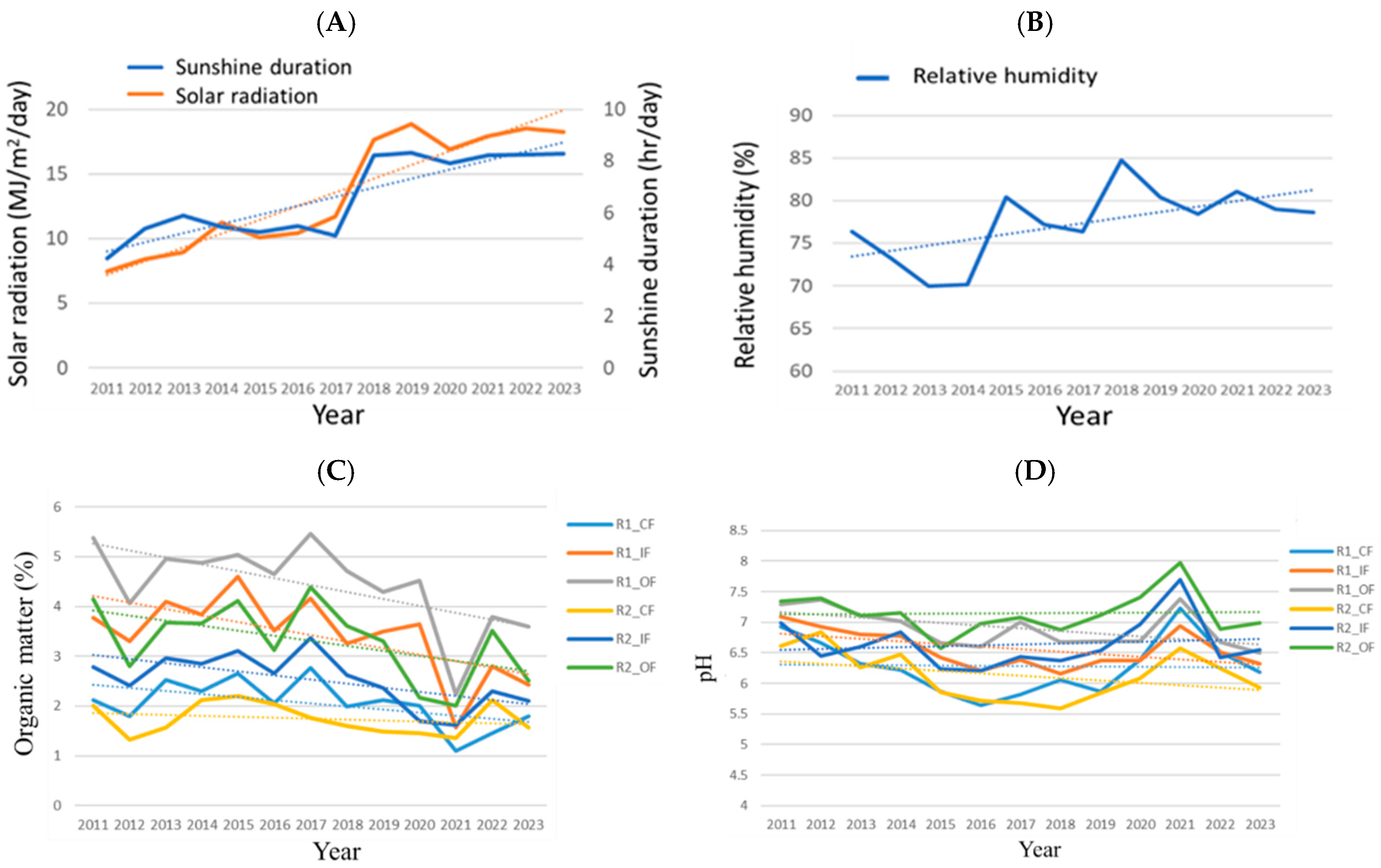
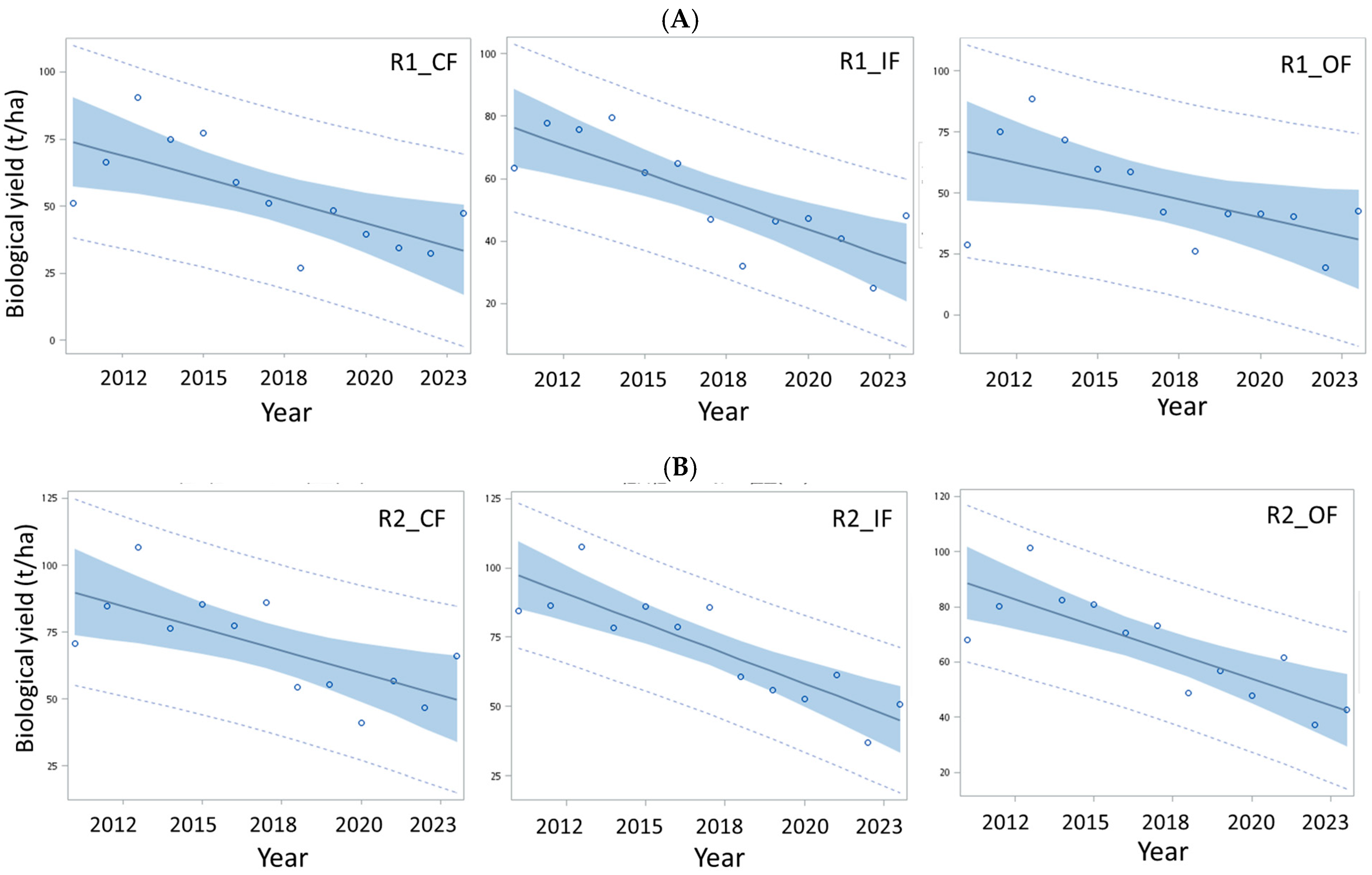
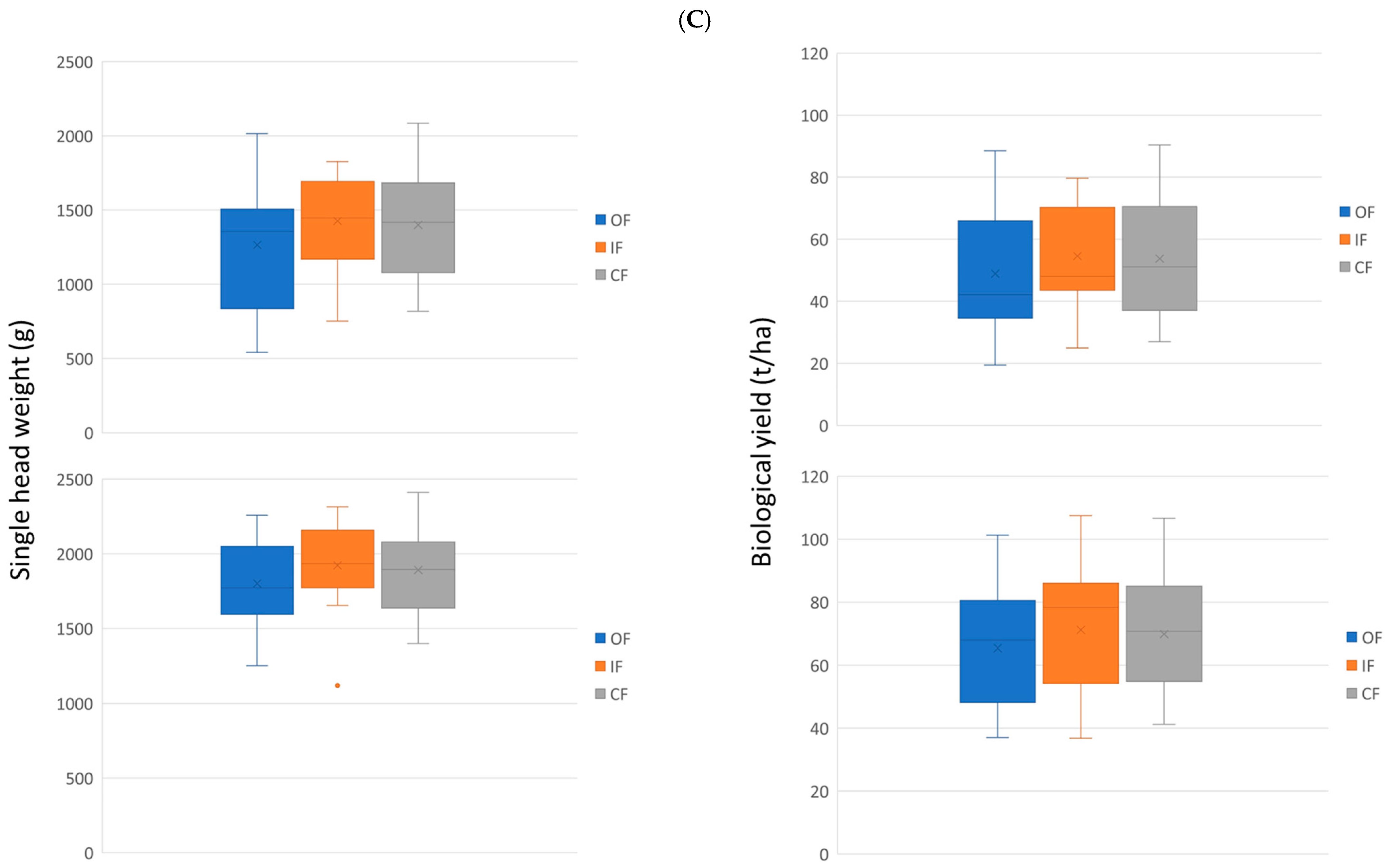

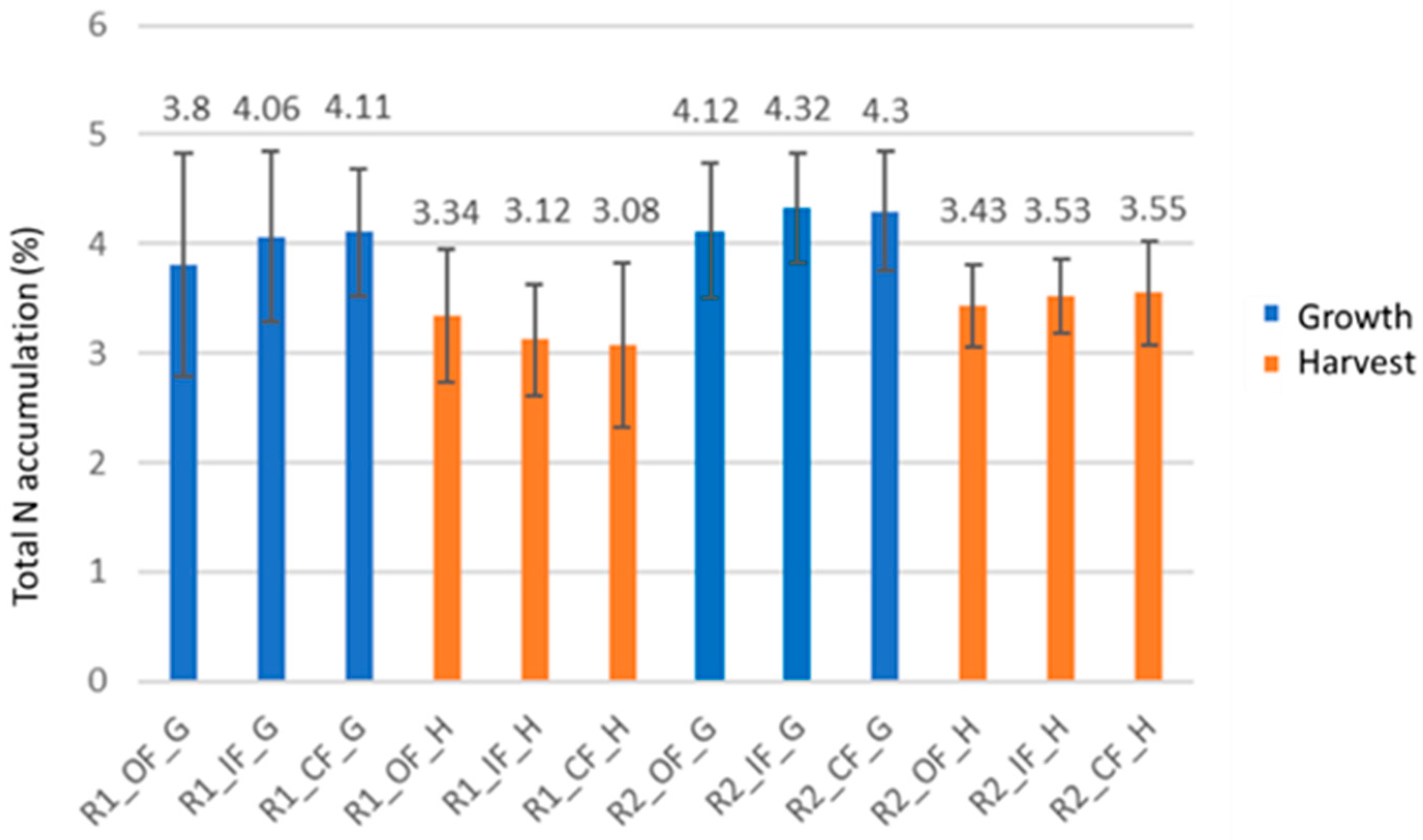
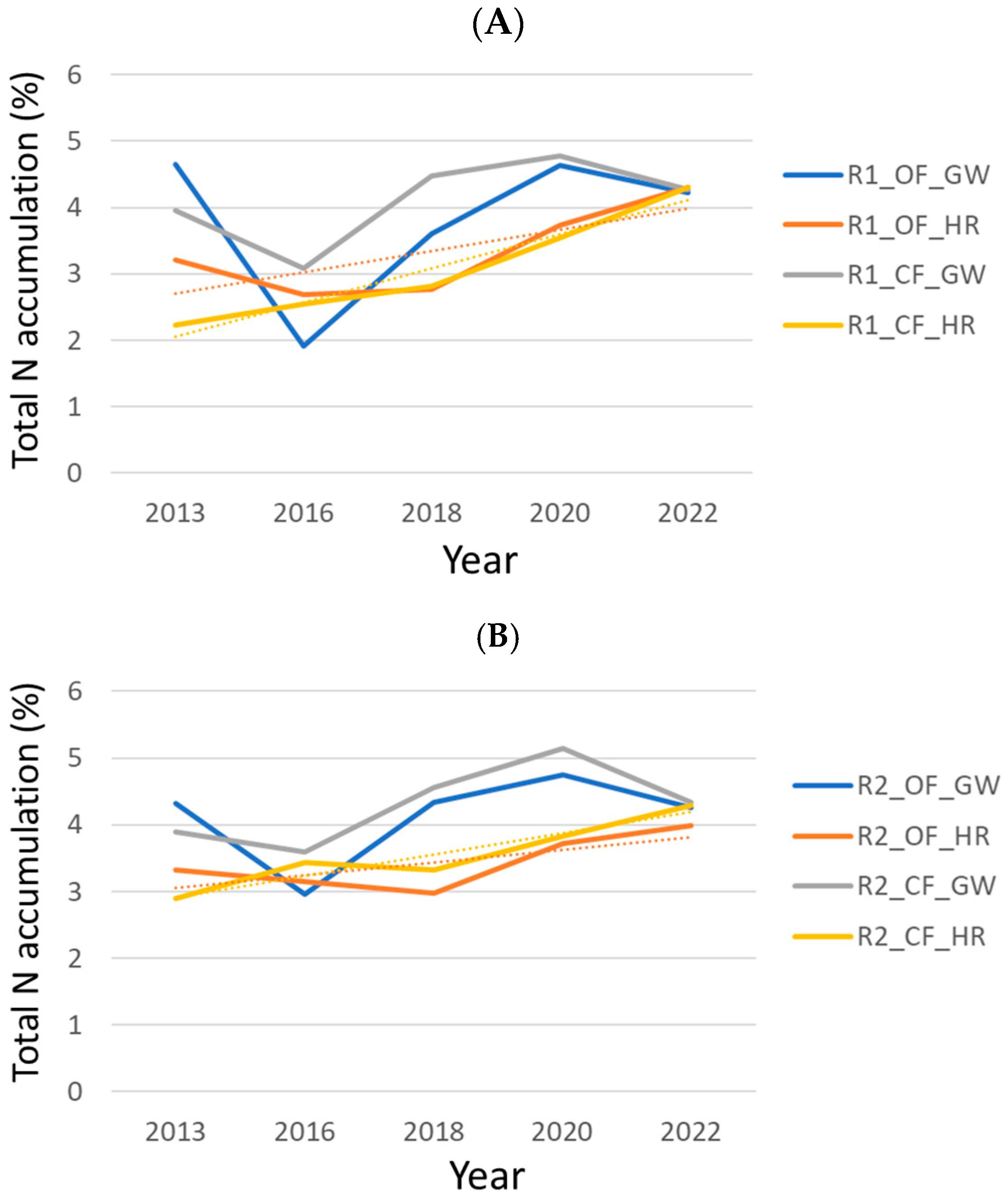
| Pearson Correlation | Value | R1 | R2 | ||||
|---|---|---|---|---|---|---|---|
| CF + | IF | OF | CF | IF | OF | ||
| Single head weight (g) | r | 0.7878 | 0.6896 | 0.8469 | 0.3777 | 0.5076 | 0.4897 |
| p | 0.0014 ** | 0.0091 ** | 0.0003 *** | 0.2032 | 0.0765 | 0.0894 | |
| Average temperature (Tave) (°C) | r | −0.1300 | −0.0875 | −0.1668 | 0.0058 | −0.0160 | −0.1176 |
| p | 0.6719 | 0.7762 | 0.5859 | 0.9848 | 0.9584 | 0.7019 | |
| Maximum temperature (Tmax) (°C) | r | 0.1127 | −0.0182 | 0.1192 | 0.1731 | 0.0325 | 0.0424 |
| p | 0.7138 | 0.9529 | 0.6979 | 0.5715 | 0.9161 | 0.8905 | |
| Minimum temperature (Tmin) (°C) | r | −0.1404 | −0.1009 | −0.2877 | −0.0005 | 0.0084 | −0.1375 |
| p | 0.6472 | 0.7428 | 0.3404 | 0.9985 | 0.978 | 0.6541 | |
| Relative humidity (RH) (%) | r | −0.7615 | −0.8067 | −0.7555 | −0.6623 | −0.6218 | −0.7044 |
| p | 0.0025 ** | 0.0009 *** | 0.0028 ** | 0.0136 * | 0.0233 * | 0.0072 ** | |
| Precipitation (Prep) (mm) | r | 0.0023 | −0.0375 | −0.2293 | 0.1080 | −0.0089 | −0.1120 |
| p | 0.9939 | 0.9031 | 0.4511 | 0.7253 | 0.9768 | 0.7154 | |
| Sunshine duration (SD) (hr) | r | −0.6725 | −0.7449 | −0.4834 | −0.7400 | −0.8314 | −0.7519 |
| p | 0.0118 * | 0.0035 ** | 0.0942 | 0.0038 ** | 0.0004 *** | 0.003 ** | |
| Temperature range (Tran) (°C) | r | 0.3290 | 0.1838 | 0.5440 | 0.2220 | 0.0984 | 0.2822 |
| p | 0.2723 | 0.5476 | 0.0546 | 0.4660 | 0.7491 | 0.3501 | |
| Solar radiation (SR) (MJ m−2 day−1) | r | −0.7540 | −0.8283 | −0.6177 | −0.8048 | −0.8963 | −0.8266 |
| p | 0.0029 ** | 0.0005 *** | 0.0245 * | 0.0009 *** | <0.0001 *** | 0.0005 *** | |
| Thermal time (DD) (°C) | r | 0.0102 | 0.0921 | −0.0048 | 0.1670 | 0.1668 | 0.0469 |
| p | 0.9734 | 0.7646 | 0.9875 | 0.5855 | 0.5860 | 0.8790 | |
| pH (1:1) | r | −0.2286 | 0.4741 | 0.2930 | 0.1043 | −0.1344 | 0.0026 |
| p | 0.4524 | 0.1016 | 0.3313 | 0.7344 | 0.6615 | 0.9932 | |
| Organic matter (%) | r | 0.6226 | 0.4859 | 0.1921 | 0.3599 | 0.4680 | 0.3964 |
| p | 0.0230 * | 0.0923 | 0.5295 | 0.2270 | 0.1068 | 0.1799 | |
| Phosphorus (ppm) | r | −0.5045 | −0.5465 | −0.4804 | −0.3324 | −0.5991 | −0.6806 |
| p | 0.0787 | 0.0533 | 0.0965 | 0.2670 | 0.0305 * | 0.0104 * | |
| Potassium (ppm) | r | −0.0603 | 0.3116 | 0.1414 | −0.2669 | −0.5734 | −0.1553 |
| p | 0.8447 | 0.3000 | 0.645 | 0.3780 | 0.0405 * | 0.6123 | |
| Calcium (ppm) | r | 0.0379 | 0.2299 | 0.2062 | 0.3782 | 0.2775 | 0.3579 |
| p | 0.9020 | 0.4498 | 0.4991 | 0.2025 | 0.3586 | 0.2298 | |
| Magnesium (ppm) | r | −0.3347 | −0.0884 | 0.2172 | −0.2222 | −0.4856 | 0.1818 |
| p | 0.2636 | 0.7738 | 0.4759 | 0.4654 | 0.0924 | 0.5521 | |
| Iron (ppm) | r | 0.3675 | 0.4078 | 0.0763 | 0.2292 | 0.3308 | 0.2149 |
| p | 0.2166 | 0.1665 | 0.8042 | 0.4513 | 0.2695 | 0.4806 | |
| Manganese (ppm) | r | 0.5171 | 0.5304 | 0.4392 | 0.0265 | 0.3298 | 0.5142 |
| p | 0.0703 | 0.0622 | 0.1332 | 0.9314 | 0.271 | 0.0722 | |
| Copper (ppm) | r | 0.4228 | 0.5874 | 0.4355 | 0.5265 | 0.6827 | 0.6434 |
| p | 0.1500 | 0.0348 * | 0.1369 | 0.0645 | 0.0101 * | 0.0176 * | |
| Zinc (ppm) | r | 0.5094 | 0.4764 | 0.3834 | 0.4686 | 0.1310 | 0.2779 |
| p | 0.0754 | 0.0998 | 0.1958 | 0.1063 | 0.6697 | 0.3579 | |
| Sodium (ppm) | r | 0.3338 | 0.4608 | 0.0872 | 0.1800 | 0.3499 | 0.6257 |
| p | 0.2649 | 0.113 | 0.7768 | 0.5562 | 0.2412 | 0.0221 * | |
| Electrical conductivity (1:5; dS m−1) | r | 0.5831 | 0.2548 | 0.1128 | 0.5737 | 0.3078 | 0.5706 |
| p | 0.0365 * | 0.4007 | 0.7135 | 0.0403 * | 0.3061 | 0.0417 * | |
| Treatments | Multiple Regression Equation + | Model p-Value | R2 |
|---|---|---|---|
| R1 | Yield = −34.055 − 0.3612(RH) + 15.770(Tran) *** − 3.265(SR) *** | <0.001 | 0.770 |
| R2 | Yield = −2.151 + 12.303(Tran) *** − 3.897(SR) *** | <0.001 | 0.857 |
| R1 with R2 (N = 78) | Yield = −37.694 + 14.771(Tran) *** − 3.712(SR) *** | <0.001 | 0.659 |
Disclaimer/Publisher’s Note: The statements, opinions and data contained in all publications are solely those of the individual author(s) and contributor(s) and not of MDPI and/or the editor(s). MDPI and/or the editor(s) disclaim responsibility for any injury to people or property resulting from any ideas, methods, instructions or products referred to in the content. |
© 2025 by the authors. Licensee MDPI, Basel, Switzerland. This article is an open access article distributed under the terms and conditions of the Creative Commons Attribution (CC BY) license (https://creativecommons.org/licenses/by/4.0/).
Share and Cite
Hou, P.-F.; Chang, Y.-T. Exploring the Impact of Different Fertilization Practices and Regional Climate Variables on Cabbage (Brassica oleracea L. Var. Capitata) Yield. Sustainability 2025, 17, 6086. https://doi.org/10.3390/su17136086
Hou P-F, Chang Y-T. Exploring the Impact of Different Fertilization Practices and Regional Climate Variables on Cabbage (Brassica oleracea L. Var. Capitata) Yield. Sustainability. 2025; 17(13):6086. https://doi.org/10.3390/su17136086
Chicago/Turabian StyleHou, Ping-Fu, and Yao-Tsung Chang. 2025. "Exploring the Impact of Different Fertilization Practices and Regional Climate Variables on Cabbage (Brassica oleracea L. Var. Capitata) Yield" Sustainability 17, no. 13: 6086. https://doi.org/10.3390/su17136086
APA StyleHou, P.-F., & Chang, Y.-T. (2025). Exploring the Impact of Different Fertilization Practices and Regional Climate Variables on Cabbage (Brassica oleracea L. Var. Capitata) Yield. Sustainability, 17(13), 6086. https://doi.org/10.3390/su17136086







